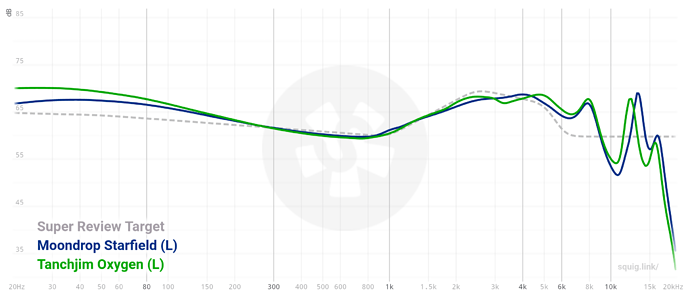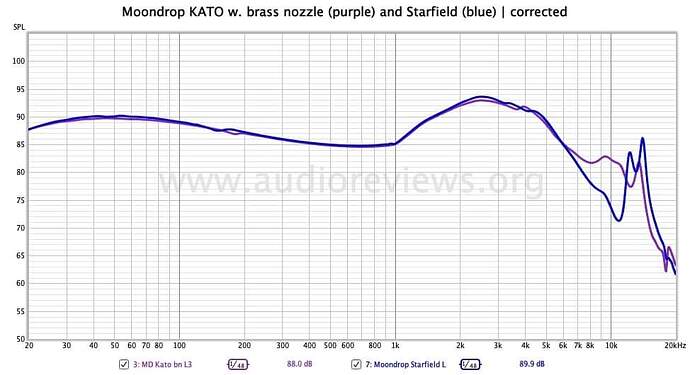Oh boy! Positive impression huh? Well shit. Now I don’t know what to get, the KATOs or the Teas.
Depends what you like. Teas will have more laid back treble (as in be less sibilant) but be better at the technical stuff like separation, detail retrieval, etc. The kato will have better timbre and coherency as it’s a single dd. It’s worth mentioning that they aren’t even in the same price bracket. You should probably Google for oxygen to tea comparisons and get whichever of the two you like more unless you want something cheaper like the KATO. In that case you’re looking at stuff like the Hana 2021 and Kato, etc.
For more indepth comparisons we’ll have to wait for reviews and actually comparisons but we can at least guess this much since the difference between good hybrids like the tea and good DD like the oxygen, Hana 2021, kxxs, kxxx, etc are pretty well documented. The kato is not a far deviation from the kxxs so it shouldnt be too hard to figure out what will suit you better.
Personally I love single dd over multi drive iems so it wasnt a hard choice for me after seeing everyone so far call it a better kxxs.
The FR curve is extremely similar to the oxygen, in fact more so than to the starfield/kxxs imo on the brass nozzle. The steel nozzle looks verryyy similar in tuning to the illumations, in fact it looks like a warmer version. Otto motor himself said he likes the steel nozzle Kato more than the much more expensive illumination.
I think moondrop is doing to themselves what they did to the kxxs/starfield with the aria, but to the illumination now (and possibly the oxygen) with the kato lmao. From what I’m able to tell these aren’t as resolving as the oxygen (according to animagus on head-fi) but they come very damn close. So these could be like a cheaper oxygen option that comes very close and may actually do a few other things better.
The people shitting on the graphs just took one look at it and didn’t really make anything out of it I think lmao. Yeah it’s the same as starfield tuning but it has the 6-14k dip/energy loss removed, which is huge and brings it close to the oxgyen.
The oxygen has almost the same FR curve as the starfield but with more energy in the treble end and sub bass but nobody talks about that so it boggles my mind that people can complain about moondrop reusing the tuning again with only moderate changes in the kato. If the oxygen is considered the king of DD why wouldn’t they reuse the same tuning and only make small changes that follow a similar direction as the oxygen? Just look up anyone’s squig and compare the starfield to the oxygen. Now go look at the starfield vs KATO graph posted above.
Even the starfield and aria had a purpose when reusing the tuning with almost no changes, it gave us kxxs sound for a lot cheaper with each release. It’s not like that’s what they’re doing here. They’re trying to make a moderate change in a tuning that already works and is similar to what’s considered the best DD iems by many, provide a better cable, some hardware tech update, spec upgrade, etc. Looking at the comments from before now, the ones like a “worse kxxs” just from judging a graph are funny to me cause the oxygen graph looks almost like the starfield graph with the only differences being very similar to the kato graphs difference. Sure the kato may actually end up being worse than the kxxs, I won’t write that off until we got more reviews but some of the comments we had just off the graph have been silly, especially when we use the oxygens graph to put things into retrospect.
Edit: graphs to further compound my point
From what I can tell the kato are actually way closer to the oxygen in tuning than to the starfield. Down to how the dip around 10k is less, and how the whole treble end frequency looks a bit pulled back like the oxygen curve.
From crinacle’s oxygen review
A common comparison point would be Moondrop’s own KXXS, an update to their popular Kanas Pro model. Apart from mild differences such as a small increase in sub-bass response in the the KXXS as well as the Oxygen’s slightly smoother transition from 4kHz to 8kHz, on paper the two can be considered as basically identical.
Now look at the starfield to Kato comparison graph. Something sound familiar?
Well, since I need an IEM that can do some technical stuff that is even better than the ones I have. I think it’s safe to say that the KATOs can wait, I would probably get the KATOs if one of my Moondrop IEMs suddenly broke or gone missing.
The new matte finished version looks dope.
I’d wait for a comparison with KXXS and Oxygen.
I’ll be doing exactly that. 
For me the DD war ended two years ago “oxygen” and a new war has begun “planar” Let’s be honest, even if they beat it won’t be by much cz i think that oxygen already achieved nearly the limet of what can dd offer
I think the consensus is that SoftEars Turii is the best DD in the world, all things considered ($1399 tho).
I will never pay 1.4k for a single dd set for me 300$ maybe 400$ max
I think DD can go a little further. It’s mostly lacking at higher frequencies technical ability wise but at the same time DD treble sounds way better than BA/planar/est because one it has more weight, and two it has way better timbre. So if DD can be improved to the point where it gets close to ba/est/planar performance we would have something really special. It’s easier to do with more space, like full size headphones, speakers, tweeters, etc but hasn’t really been done yet in iems, at least well. I wonder if this can be achieved with multi DD iems. I know the na2+ does a good job by using dual cavities so that’s an option as well. The dq6 is an interesting take using triple DD but it’s probably too cheap to really put the concept to test.
UM 3DT if you want the step up of 3DDs
The next step up from the DQ6 would be the unique melody 3dt. I am sure the tech can be made better in the future. I will say based on speakers most likely there will always be trade offs with different types of transducers.
The 3DT has one 10mm and two 7mm DDs.
Wouldn’t it be more sensible to have a bigger DD for low and and an ultra small DD for the top end?
Like 12mm - 8mm - 4mm
Yeah, to me it would make sense.
The dq6 is doing that I believe.
Seems the DQ6 runs one 10mm and two 6mm, so same philosophy as 3DT.
Yeah, but the bigger one is the bass/mids, while the 2 6mm dds are used for treble.
From what I read, DQ6 uses its larger DD for bass, whereas 3DT goes the other way round : small double DD for fast & textured bass, large DD for mids and treble.
From what I’ve gathered from building “full-range” 2ch speakers using the likes of Mark Audio & Fostex drivers, higher frequencies resonate on the surface of the cone rather than the push-pull of the cone.
For treble I would think the cone material and coating would have a big effect on the sound. The size of the driver I’m not sure, perhaps a bigger surface area allows for a wider range of treble frequencies to resonate? Perhaps gives a larger soundstage as well?
So yeah the 2x small drivers working in tandem for fast textured bass makes sense and one for mids and treble would make sense to me.
Definitely gonna check this out if I like the graph and the DQ6 I have on the way.
Yeah I was wondering the same thing, or better yet, just two DD, maybe one 9.2mm and some smaller one. From what I understand the actual size of the DD doesnt matter too much, its more about the material used. The struggle with DD in IEMs (vs BA/etc) is that they don’t have enough space to work with to produce large treble extension. Using only two DD and keeping them a little smaller may help with the space issue, the trade off being that they will probably be harder to drive and need more power.
If you actually listen to the 3DT you would understand why they did 2DD for the low end. By stacking them they way they did you get extra note weight and force on the low end while having a very quick response… I haven’t heard another IEM with as much force while still being fast enough for more technical metal tracks.

